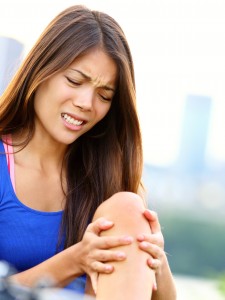What Causes Knee Pain?
Knee pain is a common injury that can occur due to imbalances in the body. The main focus to treating and preventing knee pain is the emphasis on proper core-pelvic control in conjunction with hip strengthening exercises. The core-pelvic area is the foundation for proper movement patterns and is very important for helping maintain stability of the body. Often generalized knee pain is referred to as Patellofemoral Pain Syndrome or PFPS.
To explain this simply: think about building a house. You must have a strong foundation prior to beginning construction. The core-pelvis region is the foundation, and if this area is weak, the limbs will not be controlled or aligned. Muscle firing patterns is the order in which the house is built. Certain walls need to be put up before others, just like firing patterns in our bodies. We need the core-pelvis region to fire first, in order to stabilize our spines and allow for co-ordinated movement of the hip, knee and ankle joints respectively.
The hips have many large muscle groups around them and are a major contributor in helping keep us stable. Power and movement should typically be initiated from this area. Therefore, in order to prevent injury and allow for proper rehabilitation, it is crucial to ensure that the hip is stable and the muscles are working in conjunction with one another. This will allow us to alleviate stress from being transmitted to the smaller and weaker knee joint. The core-pelvis area also works with the hips to ensure we maintain a neutral spine and help dissipate force to the lower limbs. This helps reduce pain and dysfunction in the extremities. Keeping the hips mobile is also key in order to prevent pulling or tension of the muscles that attach below the knee joint.
New research has demonstrated that the fascia, which is the connective tissue that envelops all the muscles under the skin, extends without separation. If there is fascial tension from above or below a joint it pulls on the joints around them. For example: lack of mobility in the hip will cause pulling on the knee, which can lead to pain or discomfort.
How Can You Prevent Knee Pain?
Start your program by activating the core-pelvic muscles. Yoga and Pilates exercises such as: planks, side planks and glute bridges should be used to awaken the core muscles, which should be firing first to initiate proper movement.
- Think about bracing the core as if someone is going to punch you in the stomach prior to initiating dynamic movement. Always maintain a neutral spine.
- Following the core brace, hinge from the hip allowing the knee to unlock and bend as you do the movement.
- Use the following exercises during training to help prevent knee pain by strengthening the hip gluteal muscles, which help resist abnormal knee movement.
- Single leg squats
- Clam shells
- Glute extension on all fours
- Lateral band walks
- Single leg glute bridges
- Proper landing mechanics with jumping exercises
Following your program, use stretches to prevent hip tightness as many of the muscles from the hip also attach to below your knee. Hold each stretch for minimum 40 seconds or until you feel the muscle relax and repeat twice.
- Lunges
- Standing quadriceps stretch
- Figure four quad glute stretch
(c) – Read entire story .



